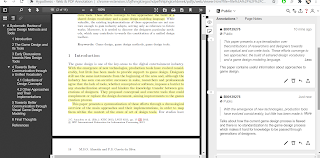Annotated Bibliography
A Systematic Review of Game Design Methods and Tools: Marcos Silvano Orita Almeida1 and Fl´avio Soares Corrˆea da Silva.
This paper contains information about different approaches to game design and talks about how the current game design process is flawed and there is no standardization to the game design process which makes it hard for knowledge to be passed through generations of designers. This paper covers new proposed ways of improving the game design/ creation process. The game design process doesn't have a broad application solution to designing games and also specific to certain genres. Designers want tools that will help improve the production of games while also reducing the risk of investing into new projects that may fail. New developers want tools that will help guide them in the right direction while also increasing productivity. Using standardized tools can help the industry build a universal knowledge base of game design.
The Game Element and Mechanic (GEM) framework: A structural approach for implementing game elements and mechanics into game experiences: Lauren S.Ferro.
The many approaches to players centred game design have resulted in a better understanding of how to create experiences that players are drawn into. By studying players gaming experiences, game designers can use the information towards their game design process to create a better experience for the players. Game designers need to create a meaningful experience for players to connect with their needs. Personalized game experiences have been the main focus of many studies. Game designers are encouraged to use typologies from players as part of their design process, this can be used with the intention of improving customer engagement with the product. Many game scholars are interested in observing the payers behaviour to understand why and how they are engaged in various game experiences.
Overlay Design Methodology for virtual environment design within digital games: Ikhwan Kim, SukJoo Hong, Ji-Hyun Lee⁎, Jean-Charles Bazin.
Designing a virtual environment for your game requires a lot of consideration and substantial editing of the many digital game components. Designing a virtual game environment requires the same amount of effort as creating a game itself. Designing a game takes a large amount of workforce and is usually the most time-consuming process for game designers. It is very important to establish an exact design system to develop a game. Game designers were interviewed to ask their opinion on what's the most challenging part of game design and the most repeated answer was the lack of a universal design system that they can all use, the second most frequent answer was the issues with communication between team members. The interviewee's said that without a clear design system, the quality of the game depends on the few more experienced game designers. Without any universal communication tool or design system between designers and programmers, it is hard to create a cohesive concept of a virtual environment into a game.




Comments
Post a Comment